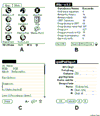Handheld computers in critical care
- PMID: 11511337
- PMCID: PMC37409
- DOI: 10.1186/cc1028
Handheld computers in critical care
Abstract
Background: Computing technology has the potential to improve health care management but is often underutilized. Handheld computers are versatile and relatively inexpensive, bringing the benefits of computers to the bedside. We evaluated the role of this technology for managing patient data and accessing medical reference information, in an academic intensive-care unit (ICU).
Methods: Palm III series handheld devices were given to the ICU team, each installed with medical reference information, schedules, and contact numbers. Users underwent a 1-hour training session introducing the hardware and software. Various patient data management applications were assessed during the study period. Qualitative assessment of the benefits, drawbacks, and suggestions was performed by an independent company, using focus groups. An objective comparison between a paper and electronic handheld textbook was achieved using clinical scenario tests.
Results: During the 6-month study period, the 20 physicians and 6 paramedical staff who used the handheld devices found them convenient and functional but suggested more comprehensive training and improved search facilities. Comparison of the handheld computer with the conventional paper text revealed equivalence. Access to computerized patient information improved communication, particularly with regard to long-stay patients, but changes to the software and the process were suggested.
Conclusions: The introduction of this technology was well received despite differences in users' familiarity with the devices. Handheld computers have potential in the ICU, but systems need to be developed specifically for the critical-care environment.
Figures
References
-
- Sado AS. Electronic medical record in the intensive care unit. Crit Care Clin. 1999;15:499–522. - PubMed
-
- Ebell M, Rovner D. Information in the Palm of your hand. J Fam Pract. 2000;49:243–251. - PubMed
-
- Edwards FH, Davies RS. The handheld computer in critical care medicine. Am Surg. 1986;52:452–455. - PubMed
-
- Fong BC, Doyle DJ. Respiratory consultant: a hand-held computer-based system for oxygen therapy and critical care medicine. Int J Clin Monit Comput. 1997;14:155–163. - PubMed
-
- Helwig AL, Flynn C. Using palm-top computers to improve students' evidence-based decision making. Acad Med. 1998;73:603–604. - PubMed
Publication types
MeSH terms
LinkOut - more resources
Full Text Sources
Other Literature Sources
Medical


